Sign up for daily news updates from CleanTechnica on email. Or follow us on Google News!
All eyes are on China as companies like BYD and Xiaomi grab all the electric car headlines, but Hyundai is quietly leading the way forward in the US when it comes to offering compelling electric cars that buyers actually want. Hyundai Motor America reported that total sales were up 2 percent in March — a healthy increase for any company in the highly competitive car business.
But the real news behind those figures is that its electric car sales showed huge gains for the month. In all, sales of its battery electric, hybrid, and plug-in hybrid cars doubled in March compared to a year ago. Sales of the Hyundai IONIQ 5 were up 58 percent in March, while sales of the Tucson plug-in hybrid rose 62 percent, the Tucson hybrid recorded a 48 percent gain, and Palisade hybrid sales rose 58 percent. Total Hyundai EV sales increased 100 percent year over year and sales of all the company’s “eco-friendly” cars were up 35 percent for the month of March on total sales of 11,485 vehicles.
“Hyundai keeps producing products that win awards and demand for our vehicles, especially EVs, remains high,” said Randy Parker, CEO of Hyundai Motor America. “We saw the best Q1 total sales results influenced by Palisade, Kona and IONIQ. We’re thrilled about the all new Santa Fe, our successful NY Auto Show where IONIQ 5 N won World Performance Car of the Year, and the introduction of the refreshed Tucson and Santa Cruz.”
Parents magazine has named the IONIQ 5 as the Best Electric 5 Passenger SUV for Families in their 2024 Best Family Cars Awards. This recognition highlights the IONIQ 5’s flexible interior, outstanding rear seat roominess, fast charging capability, and unique optional Vehicle-to-Load (V2L) adapter. At the beginning of this year, executive editor Zachary Shahan wrote, “The Kia EV9, Kia EV6, Hyundai IONIQ 5, Hyundai IONIQ 5 N, Hyundai IONIQ 6 — they’re all award winners! These are top notch electric vehicles built on a decade of good EV design and development.”
Hyundai IONIQ 5 Passes Driving Test

Another area where Hyundai shines is in self-driving cars. It is building robotaxis at its new factory in Thailand, where it concentrates on manufacturing purpose-built vehicles for particular needs. Recently one of those robotaxis actually passed a simulated US driver’s license test and was awarded a driver’s license with its picture on it!
The IONIQ 5 robotaxi completed a series of public level driving tests, including road driving in Las Vegas, demonstrating outstanding performance. This achievement underscores the IONIQ 5 robotaxi’s reliability as well as the inclusivity of its autonomous vehicle technology, highlighting its potential to safely provide freedom of mobility to all.
The video starts with an interview with Pearl Outlaw, a visually impaired American woman, and her mother, Ruth. Pearl faces mobility limitations due to her condition, called Retinitis Pigmentosa, which hinders her from obtaining a driver’s license, which is an essential symbol of independence and freedom for many people. Her story highlights everyday mobility challenges for the physically impaired, emphasizing the significance of autonomous driving technology in providing independence. The IONIQ 5 robotaxi promises to fulfill her dream of independent mobility while offering the freedom to explore without reliance on others.
“I’m a DMV Certified Driving Examiner with 25 years of experience. In that time, I’ve failed thousands and thousands of students in the interest of public safety. It’s going to be the same criteria — just like testing a human. We’ll be monitoring the speed, lane changes. I’m going to grade maneuvers, making a complete stop, left turns, maintaining the lane, and of course reaction time,” said Kandice Jones, the driving test examiner who tested the IONIQ 5 robotaxi.
In the driving test, the robotaxi excelled, impressing Jones with its speed control, lane changes and maneuvering, its ability to accurately stop at a stop sign and perform left turns, and its reaction time to developing hazards. The IONIQ 5 robotaxi effortlessly navigated the Las Vegas Strip, as well as the city’s suburban areas.
The IONIQ 5 robotaxi is the embodiment of transformative technologies in mobility coming together in one vehicle, the company says. It signifies the extensive collaboration between Hyundai Motor Group and autonomous driving technology developer Motional, spanning years of development and rigorous testing of advanced automotive platforms and self-driving technology. The IONIQ 5 robotaxi achieves consistent driving performance in various driving environments thanks to its suite of advanced sensors, combining LiDAR, radar, and cameras.
“As a company that pursues freedom of mobility, we at Hyundai aim to exhibit the safety and trustworthiness of the IONIQ 5 robotaxi through this campaign. We will continue our efforts to communicate our AI-based autonomous driving technology, which is set to provide positive changes to our customers’ everyday lives,” said Sungwon Jee, senior vice president at Hyundai Motor Company.
Tbe IONIQ 5 robotaxi is no thing of beauty with its suite of digital sensor hanging from various body parts, but it works. Self-driving rival Tesla refuses to festoon its cars with such uglifying hardware, and its robotaxi program has been delayed for years. The question for the future will be whether a true robotaxi can make what looks like an unassuming conventional car. If anyone can pull that off, it is Elon Musk, but he has been at it for eight years now and some are beginning to doubt that train will ever arrive at the station.
Hyundai IONIQ 5 N
There is yet another variation of the IONIQ 5 that is making waves. Hyundai’s global auto racing activities are conducted under the umbrella of its N division. Just as the original Volkswagen Golf spawned the GTI, the IONIQ 5 N is a high performance version of the regular car designed to appeal to drivers who demand more from their vehicle.
Hyundai says the IONIQ 5 N is “the new benchmark for high performance, all electric driver engagement” and will be priced at $66,100 before a $1,375 destination charge. Call it $67,475 out the door. That price includes a driver assistance platform that is supposed to be similar to Tesla’s Full Self Driving package. The IONIQ 5 N packs dual motors with a combined output of 601 hp (448 kW). There is also an available boost mode that pushes that to 641 hp (478 kW) for limited bursts for those who want to make the jump to hyperspace more quickly. Press the exhilarator, disappear over the horizon. Cool!
Hyundai IONIQ 5 N eN1

For decades, Porsche has made special competition models of its 911 sports car. These Club Sport editions come from the factory without air conditioning, 17 way power seats, leather upholstery, and high audio systems with 48 speakers. They hark back to the early days of sports cars when anything that didn’t make the car faster was unwelcome. Heaters, windshield wipers, roll up windows? Don’t need ’em.
Hyundai intends to create a new racing series for electric cars and has created the IONIQ 5 N eN1 expressly for that series. It uses the same basic powertrain as the N version but adds some serious go fast items like 6 piston front brake calipers backed up by 4 piston calipers in the rear, a dedicated racing seat, an internal roll cage, racing seat belts, slick racing tires, and adjustable dampers. The exterior features a front splitter and large rear airfoil. Not your average grocery getter, in other words.
“We are incredibly proud to unveil the IONIQ 5 N eN1 Cup car, demonstrating our commitment to sustainable racing. This unique electric racing car demonstrates our cutting-edge technology and passion for pushing the boundaries of what EVs can achieve on the racetrack,” said Till Wartenberg, the head of Hyundai’s N brand and motorsport division.
The Takeaway
Hyundai is moving boldly in several directions at once as part of its plan to offer a wide range of models — from mild to wild — for folks who want an alternative to conventional gasoline-powered cars. CleanTechnica readers will note how different its approach is from that adopted by Tesla, which has a limited model lineup, a few colors to pick from, and a choice of wheel covers.
That’s not to say that Tesla’s approach is wrong. It is the electric car sales leader in many markets, including Europe. Having a limited number of choices keeps manufacturing choices low and costs low, but people like choices and Hyundai is giving them what they want. Its growing sales numbers suggest the strategy is working.
Have a tip for CleanTechnica? Want to advertise? Want to suggest a guest for our CleanTech Talk podcast? Contact us here.
Latest CleanTechnica TV Video
CleanTechnica uses affiliate links. See our policy here.




